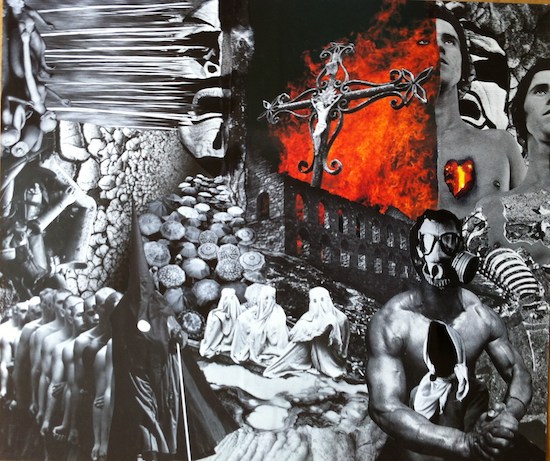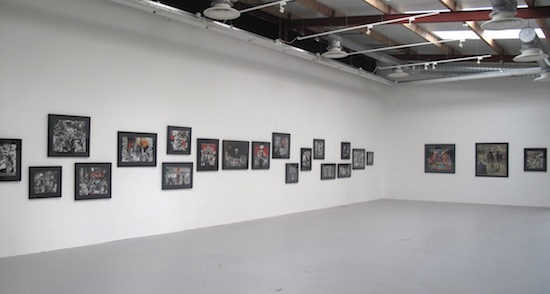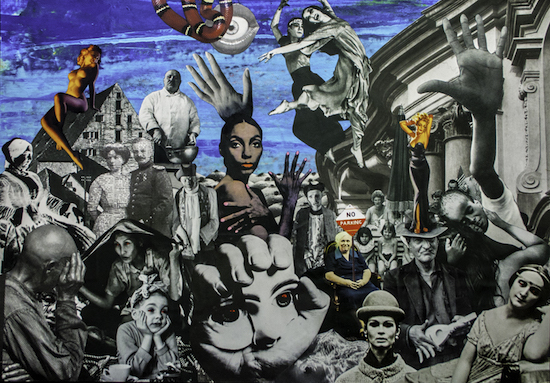As founder and principal member of the avant-garde group Nurse With Wound, Steven Stapleton has produced a steady output of sonic experimentation since the release of the seminal Chance Meeting on a Dissecting Table of a Sewing Machine and an Umbrella in 1979. Followers of Nurse With Wound will be familiar with Stapleton’s graphic work through the album art he has created for the group and others including Coil, The Legendary Pink Dots, and Current 93, often produced under the pseudonym Babs Santini. Less, however, is known about the extensive body of work that he has generated in collage, painting, and assemblage.
Many of these works have been brought together at Burren College of Art for Stapleton’s first major solo exhibition, Doing What We Are Told Makes Us Free. Together they provide a rare opportunity to experience his multidimensional approach to visual art, which complements and expands the processes that he deploys in generating his musical and sound artworks.
Collages form the main body of works in the exhibition. Both galleries are densely populated with imagery culled from multiple sources. As with Nurse With Wound’s nod to the early twentieth century avant-garde movements of Dada and Surrealism, Stapleton’s use of collage simultaneously opens up the trajectory of modernist experimentation and collapses it into our hyper-mediated present. An acute awareness of the use of montage, from the graphic works of John Heartfield and Hannah Höch to the cinema of Dziga Vertov, permeates a visual sensibility that flows from the surreal and macabre to the erotic and political. Stapleton eschews the digital to embrace a low-tech, analogue approach to art-making. Manually cutting and assembling appropriated images from books and magazines, he carefully composes hallucinatory dreamscapes. While some invoke a dystopian vision that is nightmarish and Kafkaesque, almost all are underpinned by an absurdist and irreverent sense of humour.
Deploying Russian theorist Viktor Shklovsky’s principle of ostranenie in his visual work as well as his aural (Ostranenie 1913 is the title of an early Nurse With Wound release) Stapleton actively makes the familiar strange. Shklovsky developed the concept of ‘ostranenie’, – also known as defamiliarisation or estrangement – as a method for enhancing perception of the familiar: “The technique of art is to make objects ‘unfamiliar’, to make forms difficult, to increase the difficulty and length of perception because the process of perception is an aesthetic end in itself and must be prolonged” (Shklovsky, Art as Technique, 1917).
Demanding time, these images reward the viewer with an unfolding flow of associations that emerge through slow engagement. Works such as the Fellini trilogy reprocess images from the historical arc of photography and print to reflect a vision of the world that is at once seductive and chaotic, a theatre of the absurd. Echoing the rich visual texture of Fellini’s films they constitute a visual stream of consciousness, where dancers merge with animals and musicians, and August Sander’s Weimar era chef regards us in stoic silence. As with most of the works in the exhibition, little room is left to exit through a proliferation of images that occasionally open onto architectural vistas both claustrophobic and all-encompassing.

Steven Stapleton, No Meat for the Dogma
In The Great Ecstasy of the Basic Corrupt for example, the architecture of industrial production is turned into a totalitarian edifice. Rows of uniformed personnel stand to attention, somewhat dwarfed by the maze like geometry of the architecture. The painted red masks that cover the faces of the two men in the foreground barely conceals their pensive state, as if a deep sense of unease has undermined the hubris of the alliance between the corporate and the militaristic. Likewise, the political informs Thank God For American Foreign Policy. In this work, a dense tangle of children’s bodies spills across a ruptured landscape, the social fabric rent asunder. The arms of a central figure are raised in appeal to a higher power, yet his body has morphed to become a twisted, anthropomorphic vegetable. Humour here is disquieting and the body is at once absurd and vulnerable.
These later works in particular foreground the title of the exhibition. Lifted from a track on the Nurse With Wound Dark Fat release, the phrase Doing What We Are Told Makes Us Free conjures up the power of hegemony and mass manipulation. Other works allude to the contemporary phenomenon of the whistleblower and the work of filmmaker Adam Curtis, who continues to probe the mechanisms of social control. Through the use of displacement and disruption Stapleton decouples the codes of such control. In detaching and reconstituting fragments from conventional narrative streams his images elude fixed meaning, forcing the question back onto the viewer. Combined with his sense of play, chance, and association, they constitute a visionary antidote to the normalising drive of our image-saturated digital landscape.

Steven Stapleton, Doing What We Are Told Makes Us Free, installation shot, The Gallery, Burren College of Art
The exhibition opened with a ‘Sleep Concert’, where Stapleton remixed his audio work as a somnambulistic DJ. Rows of air mattresses were laid out in the gallery amid the works in the exhibition and reclining attendees drifted in and out of consciousness over the course of the evening. As the light dimmed, video projections of the films of the late Paddy Jolley and former Nurse With Wound collaborators Freida Abtan and Graham Bowers filled the gallery space in hypnotic accompaniment. The latest in a series of such concerts – which have been performed in settings as diverse as a planetarium and a vintage railway terminal – this was the first to bring together Stapleton’s audio and visual work to create an immersive environment.
In expanding the visual into the aural and ceaselessly experimenting with sound and image, Steven Stapleton defies categorisation and dispenses with convention. In this light, the boundary-pushing legacy of the avant-garde and subsequent countercultural currents remains prescient. Perhaps we don’t have to do what we are told in order to become free.
Steven Stapleton, Doing What We Are Told Makes Us Free, is at The Gallery, Burren College of Art, County Clare, Ireland, until 16 June 2017


